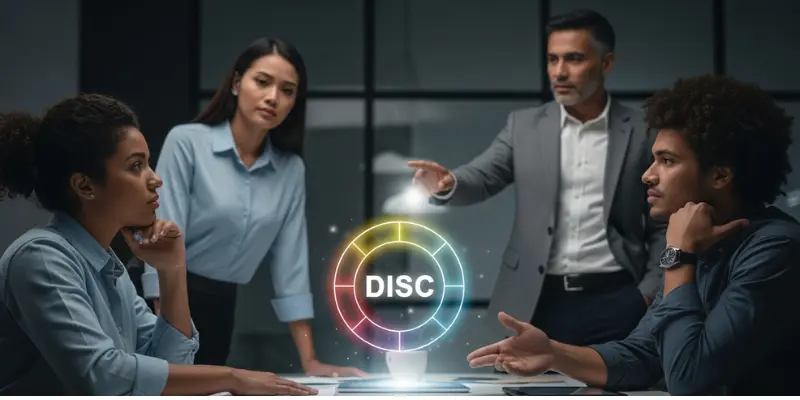DISC Personality in Team Management: A Leader’s Guide
Published: 29 Sep 2025
Welcome, Ambitious Souls!
Do team conflicts consistently slow down your progress, regardless of how skilled your members are? That’s often a sign of mismatched communication styles rather than a lack of capability. DISC personality in team management is a proven framework that helps leaders understand different work behaviors and align them for better unity. When used well, it turns team differences into performance strengths.

I’m Tanveer, a team development strategist with years of hands-on experience helping leaders build high-performing teams. In this article, I’ll walk you through how DISC works, why it matters, and how to apply it practically in your team.
By the end, you will have a better understanding of your team and know how to work effectively with each individual’s personality. Let’s explore how teams work together; keep reading to enhance your leadership skills.
DISC Personality in Team Management
DISC is a simple tool that helps us understand how people behave and communicate at work. Think of it like a map that guides leaders through the different ways team members think and act.
Great teams don’t just happen—they’re built when leaders understand how each personality moves the group forward.Tanveer
In my years of working with teams, I’ve seen how understanding these styles can transform confusion into effective teamwork.
- Dominance: Those who take charge.
- Influence: People who inspire others.
- Steadiness: Team players who keep things calm.
- Conscientiousness: Those who focus on details.
By recognizing these types, managers can lead more effectively, help teams work together smoothly, and foster stronger, more effective relationships.
Why Understanding DISC Matters in a Team Setting
Understanding DISC helps teams work more effectively by recognizing the different personality styles. It reduces misunderstandings and builds stronger connections. This creates a more positive and productive team environment.
1. Preventing Miscommunication and Conflicts
Misunderstandings often happen because people think and express themselves differently. For example, a Dominant team member might push for quick decisions, while a Steady person prefers more time and calm. These clashes can feel like trying to tune a guitar that’s out of tune.
From my experience, when teams learn DISC, they recognize these differences and avoid unnecessary conflicts, creating a smoother working environment.
2. Enhancing Collaboration and Harmony
Each DISC type brings unique strengths to the team, like different instruments in an orchestra playing together. When balanced well, Dominant members drive results, Influencers energize the group, Steadies keep peace, and Conscientious types ensure accuracy.
I’ve seen teams improve their creativity and output simply by appreciating how these personalities work side by side.
3. Making Leadership More Adaptive
Good leaders don’t use one style for everyone. Instead, they act like skilled coaches, adjusting their approach based on each person’s DISC type. For instance, they give clear, direct instructions to Dominant types but offer support and encouragement to Steady ones.
In my coaching work, adapting leadership styles in this way enables managers to motivate their teams more effectively and establish trust more quickly.

Applying DISC Insights to Team Management
When team leaders understand DISC, they can lead smarter, not harder. It’s like using a custom map where each person’s strengths are marked.
Using DISC in team management is like having a compass—it points you in the right direction when people pull in different ways.Adapted from leadership coaching principles
Over the years, I’ve found that applying DISC in daily team tasks brings out the best in everyone, making teamwork more natural and less stressful.
1. Assigning Roles Based on Strengths
Each DISC type suits specific tasks better, much like tools in a toolbox.
- Dominant personalities often take charge in decision-making roles.
- Influencers shine in social or creative tasks.
- Steady types excel in support roles that require patience
- Conscientious ones effectively handle data or quality control with precision.
Matching roles with personality boosts confidence and performance.
2. Setting Goals and Expectations Clearly
Not everyone hears instructions the same way.
- A D-type likes direct, fast goals.
- An I-type responds to motivation and praise.
- S-types need steady steps and reassurance.
- C-types prefer detailed plans.
As a team coach, I’ve learned that adjusting how you share goals based on DISC saves time and keeps everyone focused.
3. Resolving Team Tensions Using DISC
When tension rises, DISC acts like a guidebook for solving the issue.
- First, identify each person’s DISC type.
- Then, speak in their style directly with D-types, gently with S-types, and clearly with C-types.
- Finally, find a middle ground. I’ve used this approach in workshops, and it often turns conflict into understanding.
When you manage people the way they think, not just the way you lead, teamwork becomes transformation.Inspired by behavioral science in leadership
Disadvantages of Using DISC in Team Management
While DISC is a helpful tool, it’s not a perfect solution. Just as using a map without checking real-time traffic can lead to mistakes, relying too heavily on DISC can also result in errors.
I’ve seen teams misuse it, often unintentionally.
| 1. Over-generalization of People |
|---|
|
| 2. Misuse in Hiring or Judging Team Members |
|---|
Some managers treat DISC scores like job qualifications. That’s risky. It can lead to small-mindedness, ignoring real talent beyond personality types. |
| 3. Static Interpretation |
|---|
|
Conclusion
DISC personality in team management is more than a theory. It’s a hands-on tool to reduce conflict, increase productivity, and lead with clarity. When used wisely, it helps team leaders align people with the right roles and communicate with purpose.
I’ve personally seen the shift it creates in teams that once struggled to work together. Trust the process, but stay flexible; DISC is a guide, not a rulebook.
Want a more innovative way to lead your team? Let DISC be your starting point.
- Over 75% of Fortune 500 companies use DISC assessments as part of their leadership training and team development programs.
- The DISC model is nearly 100 years old, initially developed by psychologist William Moulton Marston in 1928, not as a test but as a theory of behavior.
- Teams that apply DISC-based management experience up to 20% higher productivity, particularly in roles that require collaboration and effective communication.
- DISC is not a traditional personality test. It measures behavior and communication style rather than intelligence or emotional health.
Frequently Asked Questions
Are you curious to learn more after discovering DISC? Here are some common questions people often ask when they start applying DISC to team management. Let’s make it simple and easy to understand.
DISC stands for Dominance, Influence, Steadiness, and Conscientiousness. These four styles describe how people behave and communicate in different situations. Each type has unique strengths that help teams function more effectively.
Yes, most people are a mix of two or more DISC types. For example, someone might be both Influential and Steady. DISC reveals your most natural style, but people can adjust their behavior according to the situation.
DISC focuses on behavioral and communication styles, while MBTI explores more nuanced personality traits. DISC is more action-focused and is often used in workplaces. It’s simpler and easier to apply in team settings.
You can take a DISC assessment online from trusted sources, such as DISC profile or Truity. It takes just a few minutes and gives you a detailed report. You’ll see your dominant traits and how you act in teams.
Yes, understanding DISC helps you see why people react differently. When team members respect each other’s styles, resolving arguments becomes easier. It’s like having a guide to smoother communication.
No, DISC is helpful for everyone, including students and employees. Anyone who works with others can benefit from understanding how different working styles interact with one another. It builds better teamwork and fewer misunderstandings.
It’s helpful to review DISC insights every few months, especially when roles change or new members join. Keep it part of your team check-ins. This way, you’ll stay aware of evolving dynamics.
Absolutely. DISC works well even in online settings by helping you understand tone, messaging style, and response speed. It makes remote communication more thoughtful and less stressful.
Yes, if misused. DISC should guide your understanding, not limit people’s options. Remember, everyone can grow and change over time.
Start by taking a DISC test yourself and then introducing it to your team. Share results, have an open talk, and match tasks to strengths. Small steps can lead to significant improvements.






Excellent dear brother, I found this article very helpful For me.
Thanks a lot.